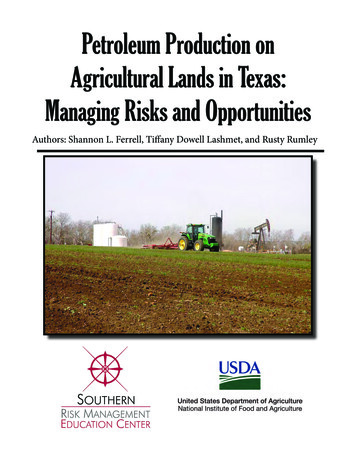
Transcription
Authors: Shannon L. Ferrell, Tiffany Dowell Lashmet, and Rusty Rumley
FundingFunding for the development of these materials was provided by the USDA NationalInstitute of Food and Agriculture through the Southern Risk Management EducationCenter, projectRME-10453.AcknowledgementsThe realm of oil and gas law is incredibly complex, and any project aimed at makingthat area of law easier to understand necessarily requires assistance from a wide arrayof experts well-versed in how the industry impacts rural landowners. The authorsgratefully acknowledge the invaluable assistance of Mr. James Decker of ShahanGuevara Decker & Arrot, Stamford, Texas, Mr. Jim Bradbury of James D. Bradbury,PLLC, of Austin, Texas, Mr. Todd Woolery of McAfee & Taft, P.C. of Oklahoma City,Oklahoma, and Mr. Derrick Davies of the Davies Law Firm, PLLC, Stillwater,Oklahoma, who provided innumerable insights to the subject matter of this workbookand reviewed its contents. The authors would also like to thank the landmen and oiland gas professionals who also provided important content for this work. Finally, thecreation and publication of this handbook would not have been possible without theeditorial support of Ms. Dylan Felger and Dr. Shelly Sitton, and the cover photo, creditBlair Fannin, Texas A&M AgriLife Extension.
To understand the issues landowners face with respect to oil and gas production ontheir land, it is important to understand the process by which oil and gas resources areexplored, produced, and transported.The extraction and use of oil and gas by humans is not a recent event. Indeed, humanshave been using them in one form or another for millennia. Many of the processesused in the production of oil and gas are based on principles decades or even centuriesold. On the other hand, there are also many new technologies surrounding the exploration for oil and gas resources. Recent advancements in the technology of horizontaldrilling and hydraulic fracturing have also created new questions for both surface andmineral owners as well.1.1. A brief history of oil and gasOil and gas, like many other fossil fuels, comes from the transformation of organicmaterials over millions of years. Most oil and gas is formed from the remains of tinyplants and animals that died and accumulated in thick layers at the bottoms of ancientseas. Over time, layers of sand, silt, and other inorganic materials accumulated on topof these remains. As more and more materials piled on top of these layers, incrediblepressures and temperatures developed. Over time, these pressures and temperaturesconverted the organic material into what we now refer to as hydrocarbons, such as coal,oil, and natural gas. Similarly, these pressures also transformed the inorganic materialabove them into rock, which trapped the hydrocarbons beneath them.1Occasionally, cracks would develop in these rock formations, allowing thehydrocarbons to reach the surface. Historians believe the first natural gas seeps werediscovered in Iran between 6000 and 2000 B.C.2 As early as 900 B.C., natural gas washarvested and used in China, where the first wells dug specifically to obtain natural gaswere dug around 200 B.C.3 The recorded use of oil by humans goes back to at least4000 B.C., when oil that had seeped to the surface was used to waterproof boats and asan adhesive for buildings and weapons.⁴1U.S. Energy Information Administration (EIA), “Natural Gas Explained: How Was Natural Gas Formed,” available e natural gas home, last accessed September 10, 2012.2Enyclopaedia Britannica, “Natural Gas,” available at atural-gas/50586/History-of-use, last accessed September 7, 2012.3Id.⁴Morgan Downey, Oil 101, 1 (2009).
North America’s first natural gas well came in 1821 in Fredonia, New York,⁵ nearly 40years before North America’s first oil well. That first well was located in near Titusville,Pennsylvania and struck oil in 1859.⁶ While natural gas use slowly expanded,petroleum developers still considered natural gas it a relatively worthless by-product ofoil production to be disposed of rather than collected and used.⁷ At least initially, oilwas favored over natural gas for refinement into kerosene for use as a lamp and heaterfuel. Gradually, though, uses for both oil and gas expanded dramatically with the use ofoil as a motor fuel and natural gas as a fuel for both heating and electrical generation.⁸Society’s increasing needs for energy have led oil and gas developers to constantly seeknew technologies for extracting resources. The two technologies responsible for thesignificant growth of oil and gas production in recent years – horizontal (sometimescalled “directional”) drilling and hydraulic fracturing (sometimes called “fracing” or“fracking”) – have actually been in use for decades. Relatively recent breakthroughsin these technologies made tremendous differences in their application, though, andmade development of many more oil and natural gas resources an economic possibility.1.2. Exploring for oil and gas resourcesSome of deposits of oil and gas occur so close to the surface that they actually seep outof the ground, like the deposits of gas tapped in Fredonia, New York or the oil seeps ofTitusville, Pennsylvania.⁹ More commonly, though, developers must drill wellshundreds or thousands of feet beneath the surface to reach formations that havetrapped significant amounts of oil and/or natural gas. Understandably, companiescarrying out oil and gas exploration and production operations (called “operators”)would like to know as much about the subsurface as possible before committing thetime, resources, and money needed to drill a well.Generally, the oil and gas industry works to locate traps because they represent theeasiest and therefore most economic sources of the resource. In the early days of⁵U.S. Department of Energy, “The History of Natural Gas,” available at ns/gas/gas history.html, last accessed September 10, 2012.⁶Downey, supra note 4 at 2.⁷Encyclopaedia Britannica, supra note 2.⁸See U.S. Department of Energy, “The History of Natural Gas,” available at ns/gas/gas history.html , last accessed September 10,2012⁹Martin S. Raymond and William L. Leffler, Oil and Gas Production in Nontechnical Language, 1 (PennWell, 2006).
the oil and gas industry, oil and gas operators looked for signs in the surface of land thatmight indicate sub-surface structures holding oil and gas. Subsurface traps and “domes”were known to create areas where oil and gas would gather and thus represented a betterchance for the producer to locate a good well. For example, in 1866 Lyne T. Barret hit oilnear Oil Spring in Nacogdoches County while drilling near a known oil seep.1⁰ Thus,operators looked for corresponding signs of these structures on the surface of the land. Ifthe operators felt confident they had enough evidence for a good well, they would drill awildcat or “exploratory” well to determine if oil and gas actually were present in theformation.Figure 1-1: Examples of oil and gas “trap” structures11Eventually, new technologies arrived to provide much more detail about the subsurfacestructure of the Earth, improving the ability to pinpoint the location of oil and gas resources. One way of detecting potential oil and gas formations was the1⁰Texas State Historical Association, “Oil Exploration,” available at o15,last accessed February 15, 2016.11Image source: Wikimedia Commons, https://commons.wikimedia.org/wiki/File:Oil traps.svg, contributed by MagentaGreen.
use of a gravimeter (or “gravity meter”) to measure the strength of gravity in an area.Since oil and gas are less dense than the surrounding rock, a weaker gravitymeasurement can indicate the presence of oil and gas. Another detection tool is amagnetometer, used to measure the Earth’s magnetic field. Higher than averagemagnetic field strengths in an area can suggest displacements in the subsurface thatcould indicate oil and gas traps. The magnometer was used in Texas to discover theYost field in Bastrop County in 1927.12Today in Texas, seismic (sometimes called “vibroseis”) exploration is frequently used toexplore for oil and gas. In fact, seismic detection has been used in Texas since 1923.13Seismic exploration directs waves of sound energy into the ground and uses sensors torecord the reflection of those sound waves off of the subsurface rock layers.1⁴ Bymeasuring the differences in these reflections, petroleum geologists can visualize theshape of the formations and can locate areas likely to contain oil and gas traps,1⁵ muchlike a sonogram uses vibrations and echoes to create images of what lies underneaththe skin of patients.Different techniques may be used to generate the sound based on the local conditions.In most situations, a large truck (sometimes called a “vibrator” or “thumper” truck)will use hydraulic rams and the weight of the truck to generate the vibrations needed togenerate the seismic data.1⁶ In other cases, holes may be dug between 60 and 100 feetdeep to place explosives into the bedrock; these explosives are then detonated togenerate the sound waves used for seismic data.1⁷ Approximately 70% of seismicoperations use thumper truck operations; shot hole operations generally are moreexpensive and are used only where thumper truck operations are impractical.1⁸1²Texas State Historical Association, supra note 10.1³Id.1⁴Norman J. Hyne, Nontechnical Guide to Petroleum Geology, Exploration, Drilling, and Production, 213 (PennWell,2001).1⁵Id.1⁶Id.1⁷Id. at 214.1⁸Hyne, supra note 14 at 214.
Figure 1-2: Thumper trucks1⁹Figure 1-3: Shot Hole Drill²⁰1⁹ Image source: Wikmedia Commons, rucks%2C Noble Energy.jpg, contributed by BLM Nevada (Flickr: Noble Energy).2⁰Image source: Wikimedia Commons, https://commons.wikimedia.org/wiki/File:Shot Hole DrillARDCO c-1000 Drill.jpg, contributed by Wall Wip.
With either method, a series of sensors are placed on the surface to listen to theechoes of the vibrations, and the sensors are then connected to computers that recordthe data generated. When seismic techniques were developed in the 1920’s, geologistsrecorded information manually on sheets of paper; now, extremelypowerful computers record and analyze seismic data to create three-dimensionalpictures of the subsurface. These technologies give operators much more confidencein where to place their wells, but the occasional non-producing well (“dry hole”) stillhappens.Figure 1-4: Three-dimensional seismic imaging211.3. Bringing oil and gas to the surfaceOnce an operator feels confident they have located an area where oil and gas can beproduced profitably, they must find a way to bring it to the surface. For many years,the overwhelming majority of oil and gas were produced through traditional verticalwells, but recent years have seen significant growth in the use of horizontal drillingtechniques.²1Image source: http://cseg.ca/student/careers/petro3.htm
1.3.1. Traditional vertical well developmentTo drill an oil or gas well (“make hole” in the language of the industry), the developerattaches a bit that will cut, gouge, or break up the rock in the formations below the rigto a length of pipe called drill string. A turntable on the rig rotates the bit and drillstring to create the drilling action. As the bit digs deeper and deeper, the developeruses the rig to attach additional lengths of drill string to make the drill longer and longer.²²Conditions for the drill bit are harsh. The action of drilling creates debris that mustbe removed from the well. Drilling also generates high temperatures for the bit. Additionally, at the depth of some wells – often thousands of feet deep – the surroundingformations themselves generate tremendous pressures and temperatures. For thispurpose, the hollow drill string allows the developer to circulate drilling mud down thestring, through the drill bit, and back up to the surface of the well.²³ Despite its name,drilling mud is not simply water and dirt; rather, it is a carefully formulated mixture ofanother components designed to give it very specific properties of density and viscosityas well as allowing it to serve a number of functions in the creation of the well. Drilling mud serves a number of purposes, including creating internal pressure on the borehole²⁴ to counteract the pressure of the surrounding geologic formation; to lubricateand cool the drill bit, and to lift the drill cuttings out of the borehole. Once the mudreturns to the surface, it is processed through a shale shaker to remove the drill cuttingsand recycled until it loses its usefulness.²⁵ These drill cuttings include all of the materials removed from the wellbore and can include a wide variety of minerals and othersubstances. Operators frequently store spent mud, drill cuttings, and salt water produced form the well in a reserve pit.”)²⁶ Eventually, the developer must dispose of thematerials stored in the reserve pit or close the pit to permanently contain the materials.2²Raymond and Leffler, supra note 13.²³Id.²⁴Id.²⁵Id. at 100.²⁶Hyne, supra note 18 at 239.
Figure 1-5: Diagram of a traditional rotary drilling oil rig2⁷1) Mud tank (pit)8) Standpipe2) Shale shakers9) Kelly hose3) Suction line10) Goose-neck4) Mud pump11) Travelling block5) Prime mover (motor) 12) Drill line6) Vibrating hose13) Crown block7) Winch/draw works 14) Derrick15) Monkey board16) Stand/string of pipe17) Pipe rack/floor18) Swivel/top drive19) Kelly drive20) Rotary table21)Drill floor22) Bell nipple23) Blowout preventer (annular)24) Blowout preventer (ram)25) Drill string26) Drill bit27) Casing head28) Flow line2⁷ Image source: Wikimedia commons, https://commons.wikimedia.org/wiki/File%3AOil Rig NT8.jpg, derivative work.
To reach the targeted formation, the drill may pass through a number of formationsincluding aquifers containing freshwater, saltwater formations, and other geologic strata. Without further action by the operator, the wellbore could create the opportunityfor saltwater, hydrocarbons, or other materials to travel through it and mix with freshwater, thereby contaminating it. Thus, once the operator reaches the desired depth, adecision must be made – whether to “complete” the well or to “plug” it.If the well appears capable of producing enough oil and/or gas to justify the cost, thedeveloper will “complete” the well by installing casing.2⁸ Several types off casing willbe used to create the final structure of the well, enabling the well to withstand thepressures acting on it and to prevent the mixing of substances from the formationspenetrated by it. The first casing, called “conductor casing” serves as a foundation andguide for the casings to follow.2⁹ Next, the developer installs “surface casing.”Surface casing serves a crucial function; it must be installed to a depth below thedeepest source of fresh water encountered by the well and must be surrounded bycement to seal both the well and the fresh water-containing formation apart from eachother.³⁰ In some wells, “intermediate casing” may follow the surface casing.³1 Finally,“production casing” forms the remainder of the well down to its final depth. Afterplacing casing, the developer will pump cement down through the casing and out theend of the casing, causing it to flow back up the well around the outside of the casing(the space between the casing and the sides of the well is sometimes called the“annulus”) until it reaches the surface again.32 This process seals off the formationsencountered by the well to prevent leaking of substances from the formations and anypollution that could be caused by such leaking.33 Given the importance of thisfunction, and the immense stresses placed on the well, the concrete used must becarefully formulated and installed.3⁴2⁸ Raymond and Leffler, supra note 9 at 139.2⁹ Hyne, supra note 18 at 241.3⁰ U.S. Environmental Protection Agency, Office of Research and Development, “Plant to Study the Potential Impacts ofHydraulic Fracturing on Drinking Water Resources,” 14 (November, 2011).³¹ Id.³2 Raymond and Leffler, supra note 13 at 140-141.33 Id.3⁴ EPA, supra note 30 at 15.
Figure 1-6: Well Casing Diagram³⁵If the well seems uneconomic to produce, it will be “plugged.” After removing anycasing already in place, the developer will install a series of concrete plugs atspecific depths to seal off any zones at risk of leaking substances that couldcontaminate groundwater, including a plug at the base of the lowest depth of freshwater. 3⁶3⁵ EPA, supra note 30 at 14³⁶ Raymond and Leffler, supra note 9 at 448-449; EPA, supra note 30 at 16.
1.3.2. Horizontal drillingTo this point, the discussion has focused on the development of a traditional verticalwell. Such wells can only extract oil or gas from that portion of the well that intersectsthe hydrocarbon-bearing formation. As a result, developers sought formations thatwere highly permeable and thus allowed the oil or gas to flow to the end of thewellbore. Conversely, formations that were not highly permeable did not allow oil orgas to be recovered in amounts that justified the cost of drilling and completing thewell.Advancements in horizontal drilling technology changed the situation, though. Withhorizontal drilling, the wellbore direction can now follow along a formation that for asignificant length. This exposes a much greater portion of the wellbore to theformation than a traditional vertical well would allow.³⁷ For example, a horizontal wellin the Marcellus shale of Pennsylvania may intercept 2,000 to 6,000 feet of formationwhere a vertical well could only intercept 50 feet.³⁸Figure 1-7: Comparison of vertical and horizontal wells³⁹Developers have had the capability of drilling wells at a non-vertical angle for decades.⁴⁰These wells, sometimes called “deviated” or “slant” wells were sometimes used toaccess formations that could not be accessed by a vertical well such as formationsbeneath water or other environmentally sensitive sites, or sites that were to rugged toreach.⁴13⁷U.S. Department of Energy (DOE) Office of Fossil Energy and National Energy Technology Laboratory, “Modern ShaleGas Development in the United States: A Primer,” ES-3 (2009).³⁸Id. at 47.3⁹Image source: Lynn Helms,North Dakota Department of Mineral Resources Newsletter,” March, 2008 at 1, available at /Horizontal.pdf⁴⁰Raymond and Leffler, supra note 9 at 16.⁴¹Hyne, supra note 14 at 281-282.
However, recent advancements in drilling technology have allowed developers to havemuch greater control in directing the drill bit.⁴² This allows developers to reach horizontal distances of nearly five miles from the well pad.⁴³ Horizontal drilling also allowsfor eight or more wells to be drilled from a single wellpad, allowing a given parcel ofland to be developed by a much smaller number of surface wellpads than if verticalwells were used.⁴⁴ Horizontal wells generally require more time and expense to complete than a traditional vertical well.⁴⁵1.3.3. Hydraulic fracturingHorizontal drilling allows operators to expose a much greater area of the wellbore tothe hydrocarbon-containing formation, but even that exposure will not produce thedesired flow of oil or gas if the formation does not permit the oil and gas moleculesto migrate through the formation and into the wellbore. This issue kept developersfrom tapping into the significant reserves of natural gas contained in shale formations.Shale rock’s tight formations, in their natural state, frequently lack the pathways thatallow a well to collect oil and gas economically. That is where hydraulic fracturingmakes the difference.Hydraulic fracturing (also called “fracking” or fracing”) was first used in the 1940’s.⁴⁶Traditionally, wells that were near the end of their useful life were hydraulically fractured to stimulate the last remaining production from them. Fracturing fluid (composed primarily of water) was forced down the well at tremendous pressures to exploitweaknesses in the hydrocarbon-containing formation, opening fractures in the formation that would allow for an improved flow of oil and gas into the well.⁴⁷ Hence, theterm “hydraulic fracturing.”⁴2For a more detailed discussion of these technologies and the techniques used to direct and survey the wellbore inhorizontal drilling, see Hyne, supra note 14 at 285-294.⁴³See, e.g. Thomas M. Redlinger and John McCormick, Drilling Contractor, “Longer, Deviated Wells Push Drill PipeLimits,” March, 2011. Available at wells-push-drill-pipe-limits-8779,last accessed September 12, 2012.⁴⁴See DOE, supra note 37 at 47-48.⁴⁵Raymond and Leffler, supra note 9 at 16.⁴⁶Hyne, supra note 14 at 560.⁴⁷Id. at 422-423.
Modern hydraulic fracturing involves very precise seismic surveys of the formation tobe fractured to determine the amount, composition, and pressure of fracturing fluidnecessary to create fractures in the right rock formation.⁴⁸ Water remains the primarycomponent of most fracturing fluids, though some fluids are petroleum-based. Waterprovides a virtually incompressible fluid to generate pressure against the hydrocarbon-containing rock, giving the fluid volume, and serving as a carrier to transport theother materials. In some cases, diesel fuel may be used instead of water to modify thephysical properties of the fluid (such as the fluid’s viscosity or lubricity) or to serve as asolvent for other fluid components.⁴⁹ Fracturing fluids also contain proppant, so calledbecause it consists of particles (frequently sand, though ceramic beads or other spherical materials may be used) forced into the fractures to hold (“prop”) them open, allowing oil or gas to flow through them.⁵⁰ Fracturing fluid often contains numerous othersubstances with a wide variety of functions, as illustrated below.⁴⁸DOE, supra note 37 at 56.⁴⁹U.S. EPA, “Fact Sheet: Underground Injection Control (UIC) Program Permitting Guidance for Oil and Gas Hydraulic Fracturing Activities Using Diesel Fuels, UIC Program Guidance #84 – Draft,” available at ydraulicfracturing/upload/hfdieselfuelsfs.pdf, last accessed September 18, 2012.⁵⁰Id.
Figure 1-8: Typical fracturing fluid components⁵1Hydraulic fracturing requires significant amounts of water, frequently ranging between 4 to 6 million gallons or more to complete a well.⁵² Developers may use surfacewater from streams, rivers, ponds, and lakes if they are available; groundwater wellsmay provide water if no surface water is available.⁵³⁵¹Source: U.S. Department of Energy (DOE), National Energy Technology Laboratory, “Modern Shale Gas Developmentin the U.S.: A Primer,” 63 (2009).⁵²Kate Galbraith, “In Texas, Water Use for Fracking Stirs Concerns,” The Texas Tribune, available at r-use-fracking-stirs-concerns/, last accessed February 15, 2016.⁵³EPA, supra note 30 at 23.
Once the fracturing fluid is formulated, the developer injects it at high pressuresinto the targeted formation. This operation may take a number of fracturing trucksworking together to generate the fluid pressures and volumes needed, as shown infigure 1-9.⁵⁴Figure 1-9: Fracturing trucks working together to inject well⁵After the fractures form, the developer releases the pressure on the well. Thisallows some of the fracturing fluid to return to the surface (though the amountof this fluid, sometimes called flowback can vary greatly depending on theformation). The developer may recycle this flowback for subsequent hydraulicfracturing operations.⁵⁶ Wells may also produce salt water occurring in thetargeted formation (“produced water”). When flowback and produced watercannot be reused in the well, the developer must find a way to dispose of thewater. Options for disposal include injecting the water in an undergrounddisposal well, treating the water and releasing it to a nearby waterbody,application of the water to land, or disposal through a nearby waste watertreatment plant.⁵⁷⁵⁴See Hyne, supra note 18 at 425.⁵⁵Image source: Wikimedia commons, lic fracturing#/media/File:Frac job in process.JPG, contributed by Joshua Doubek.⁵⁶EPA, supra note 30 at 23.⁵⁷Id. at 43, 49, 81.
1.3.4. Conditioning and transportation of oil and gasOnce oil and gas are brought to the surface, the operator must find a way to get theminto marketable condition and, naturally, get them to market.Some well sites may have conditioning equipment next to the well, while others mightuse a gathering system of flowlines to move oil and gas to a central processing unitwhere the product from several wells is processed.In the case of oil, one of the most common conditioning operations is to separate theoil from any water that may be mixed with it by using a separator. Some separatorsmay accomplish multiple tasks at once by separating oil, gas, and water from eachother.Figure 1-10: Oil separators⁵⁸After the oil has been treated on-site, it will likely be stored in a tank ortank battery for storage until it is picked up by a tanker truck for delivery to atransmission pipeline site or refinery.⁵⁶Id. 23.⁵⁷Id. at 43, 49, 81.⁵⁸Image source: Sep-pro Systems, http://www.sepprosystems.com/Oil and Gas Separators.html; WorthingtonIndustries, mage-gallery1/ .
Figure 1-11: Tank battery⁵⁹With natural gas, the operator may have to remove any remaining water fromthe gas in a process called “dehydration,” often accomplished by bubbling the gasthrough a material that will absorb the water (often ethylene glycol).⁶⁰ “Sweetening”units may remove corrosive gases such as carbon dioxide and hydrogen sulfide.⁶1⁵⁹Image source: University Lands, University of Texas System⁶⁰See Hyne, supra note 14 at 369.⁶¹Id.
Figure 1-12: Natural gas dehydrator unit⁶2⁶2Image source: Guild Associates, ydrocarbon-dew-point-control-systems.html
Figure 1-13: Natural gas sweeting unit⁶3Transportation of natural gas before it has been completely processed at a gasprocessing plant is rare, as transporting the gas by pipeline is usually more efficient andeconomical. Once the gas meets the requirements to be shipped to buyers by pipeline,large compressors bring the gas to the pressure needed to move the gas through thepipeline. These compressors may be powered by natural gas, electricity, or diesel.⁶⁴Figure 1-14: Natural gas compressors⁶⁵⁶3Image source: EnerProcess, d-amine-units⁶⁴See id. at 370.⁶⁵Image source: Alan Bates, http://yogisden.us/?p 1244.
1.4 ConclusionOil and gas have been commercially produced in the United States for over 150 years,and the industry continues to be a mix of traditional practices and cutting-edge technologies. Coordinating the wide array of activities involved in discovering, producing, and marketing oil and gas and managing the economic risks associated with allof those activities requires a significant amount of work between the operator, thesurface owner, and the mineral interest owner. The remainder of this handbook isdevoted to examining these issues and helping the landowner manage their risks inthose activities.
Chapter 2 : Surface Owner IssuesWhile it might appear most of the action of oil and gas development occurs beneaththe surface of the Earth, the exploration, production, and transportation of oil and gasinvolves a lot of activity on the surface. This means operators and the people who occupy and farm the surface of land being used for oil and gas production must find waysto work together. Understanding this cooperation requires understanding the differentnatures of surface and mineral ownership, and a number of laws and practices used toharmonize the rights of the two.2.1. Severance of the surface and mineral estateIn many countries of the world, the minerals underlying the surface of land are heldby the government, and that government has the power to negotiate if, when, and howthose minerals are extracted. However, in the United States, the majority of all mineralrights – two-thirds in all – are held by private landowners, with the remaining onethird owned by the federal and state governments.The fact that most minerals in the United States are owned by private landowners cancreate some challenges. In Texas, and most other states, the ownership of the mineralestate (sometimes called “mineral rights”) can be separated (“severed”) from the ownership of the surface estate. Put another way, one person may own the rights to use thesurface of a piece of property while another person has the right to the minerals underneath the property. Further complicating matters is the fact that both the surface andthe minerals may be owned by multiple people or entities simultaneously.Many times, the mineral and surface estates are separated when a landowner holdingboth the surface and minerals (that is, a unified estate) either sells the mineral estateto a party while retaining ownership of the surface estate, or sells the surface estate toone party while selling the mineral estate to another party. Often, the deed in such atransaction may only refer to “minerals” without defining what that term means. Notsurprisingly, Texas courts have been called on to help address disagreements in themeaning of the term “minerals.”To understand all the implications of severing the mineral and surface estate, it is necessary to examine what is considered part of the two estates.
2.1.1. Substances included in the min
gratefully acknowledge the invaluable assistance of Mr. James Decker of Shahan Guevara Decker & Arrot, Stamford, Texas, Mr. Jim Bradbury of James D. Bradbury, PLLC, of Austin, Texas, Mr. Todd Woolery of McAfee & Taft, P.C. of Oklahoma City, Oklahoma, and Mr. Derrick Davies of the Davies Law Firm, PLLC, Stillwater,










